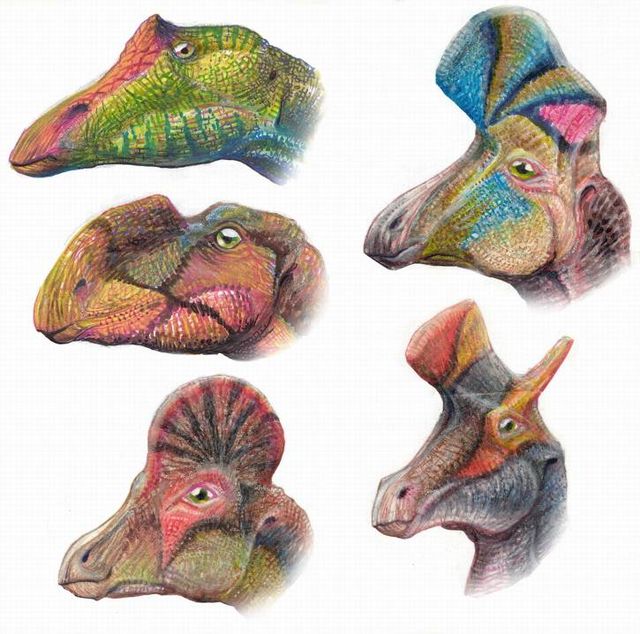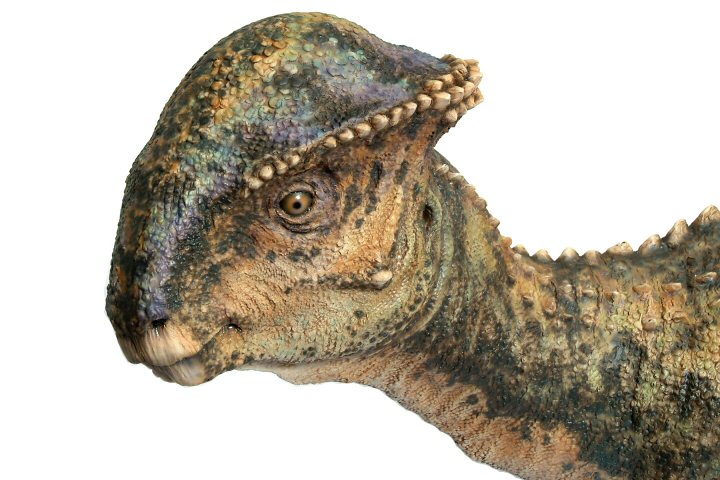 |
| The heads of some species of iguanodonts. While the colours are speculative, the head ornaments show the flamboyance of the dinosaurs. |
Head frills may have been used as part of mating displays whilst spikes and spines were primarily defensive. What has proved a little more tricky to interpret are the complex nasal structures seen inside some of the skulls: what purpose did they serve?
They may have used them to make trumpeting calls, but a recent study suggests they may have had sophisticated olfactory capabilities, as well as providing a mechanism to actually cool the brain.
'Figuring out what’s going on in their complicated snouts is challenging because noses have so many different functions,' said Jason Bourke from Ohio University, 'and it doesn't help that all the delicate soft tissues rotted away millions of years ago.' Bourke and a team of researchers used a mix of techniques, including computer modelling of airflows, CT scans and blood vessel injections to analyse the nasal structures of the dinosaurs closest living relatives - the birds, crocodiles and lizards.
'Figuring out what’s going on in their complicated snouts is challenging because noses have so many different functions,' said Jason Bourke from Ohio University, 'and it doesn't help that all the delicate soft tissues rotted away millions of years ago.' Bourke and a team of researchers used a mix of techniques, including computer modelling of airflows, CT scans and blood vessel injections to analyse the nasal structures of the dinosaurs closest living relatives - the birds, crocodiles and lizards.
The second step involved finding a suitable dinosaur group to make a comparison with. In the end they chose the pachycephalosaurs on account of the fact that their tick-domed skulls were composed of ossified cranial tissue, thus providing the researchers with a well preserved nasal system to examine.
'When we cleaned up the fossil skull of Sphaerotholus, a pachy from North Dakota, we didn't expect to see these delicate scrolls of bone in the nasal region. We knew they must be nasal turbinates,' said Emma Schachner, a co-author on the study from Louisiana State University. These were located at the back of the skull, in the same position found in its close relative Stegoceras.
'When we cleaned up the fossil skull of Sphaerotholus, a pachy from North Dakota, we didn't expect to see these delicate scrolls of bone in the nasal region. We knew they must be nasal turbinates,' said Emma Schachner, a co-author on the study from Louisiana State University. These were located at the back of the skull, in the same position found in its close relative Stegoceras.
 |
| The prominent domed skull of Stegoceras |
It was only when Bourke inserted turbinates at the front of the skull, their presence having been indicated by a bony attachment ridge in the anterior portion of the snout, that the airflow passed through the olfactory region.
This explained its highly developed sense of smell. However, it is likely that the complex nasal structure aided in cooling the brain. 'The fossil evidence suggests that Stegoceras was basically similar to an ostrich or an alligator,' said Ruger Porter, also from Ohio University. 'Hot arterial blood from the body was cooled as it passed over the respiratory turbinates, and then that cooled venous blood returned to the brain. It may not have been much of a brain, but you don’t want it cooked!'
Just a few decades ago a debate raged as to whether dinosaurs were the ancestors of the birds and were warm blooded or not. Today the focus is on the most minutest of details of their anatomy to determine how they lived, ate and even breathed.
Just a few decades ago a debate raged as to whether dinosaurs were the ancestors of the birds and were warm blooded or not. Today the focus is on the most minutest of details of their anatomy to determine how they lived, ate and even breathed.